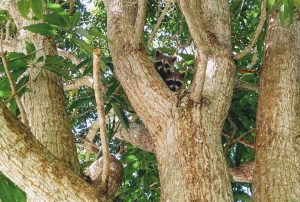Composed in night
The ringed dark moves
Delicate washed grins
The sound of garbage bins
Wandering nocturns
Fingers dexterous puzzle solvers
Fastidious cleaners
Whiskers to whisper passageways
Called unto from scented obligation
A shadow in the shadows
Movement to mimic the waning day
Peering from hollow, crevice aloft
Encircled delight in the glimpse of bottlebrush tail
Gentle gaze from accentuated dark eyeshadow
Smiling pitched purrs that evolve in the song of nyx
The majestic trash panda or Northern Racoon (Procyon lotor) meanders calmly around our human environments as if they were their own. They negotiate and solve problems with skill and adeptness that endears, confounds, and annoys. Raccoons are crepuscular (active at dawn and dusk), nocturnal, omnivores that have a wide and varied diet of everything from fruits such as acorns to insects and shellfish. Their dexterous paws turn puzzles of food around, and sharp razor teeth crunch and devour where prying fails. These relatives of weasels, bears, and coatis are prevalent throughout the world and in every county in Florida.
The development of our human societies has supported them well as agriculture and urbanization provide easy food sources for them to predate our rubbish and labor. They have incredible senses of hearing, sight and touch but their senses of smell and taste less well developed.
Their sense of touch is so astounding that they can perceive if something is edible just by touching it. Dexterous paws with five fingers, soft pads, sharp claws, and significant grip strength allow them to climb with power and skill. Racoons cannot grip things with one hand as they do not have opposing thumbs but their dexterity with front two paws in unison is extensive. Some research even suggests that raccoons utilize tools to engage with problem solving in the wild. Their strength to weight ratio is also impressive. Racoons can lift a cinder block off a garbage can, a feat that is like a human lifting their own weight to chest level then moving a few paces.

Raccoons are incredibly distinctive with grey-brown fur with black banding and white accents. The banding of their tail fur may create optical confusion of predators as they move during times of low light. Predators that hunt at night often search the dark reaches for silhouettes of their prey. The highlighting of the tail with rings may have use to the racoons as a tool of misdirection as predator’s attention would focus on the most apparent, least vulnerable part of the animal. The outlines of their eyes and faces accentuate and dramatize expressions to help racoons differentiate and identify each other.
The next time you see a wandering harbinger of night and it casually gazes at you and goes about its business in the neighborhood remember the adaptable intelligence, and capability that have evolved to a convergence in front of you. Racoons are less of an annoyance than an indicator of the distinct abundance and excess of our gathered societies. Racoons make lemonade out of our lemons and consume a wide variety of species in the environment that we would consider pests. Although there are risks having them in the environment, if you properly manage spaces and provide conduits of green around our built environment, wildlife can flourish without becoming a nuisance. It is only when we get casual, wasteful, or inefficient that wildlife species become pests. Our interactions with wildlife provide us with the opportunity to observe the delicate balance between the natural world and the world we have created for ourselves.
 1
1
